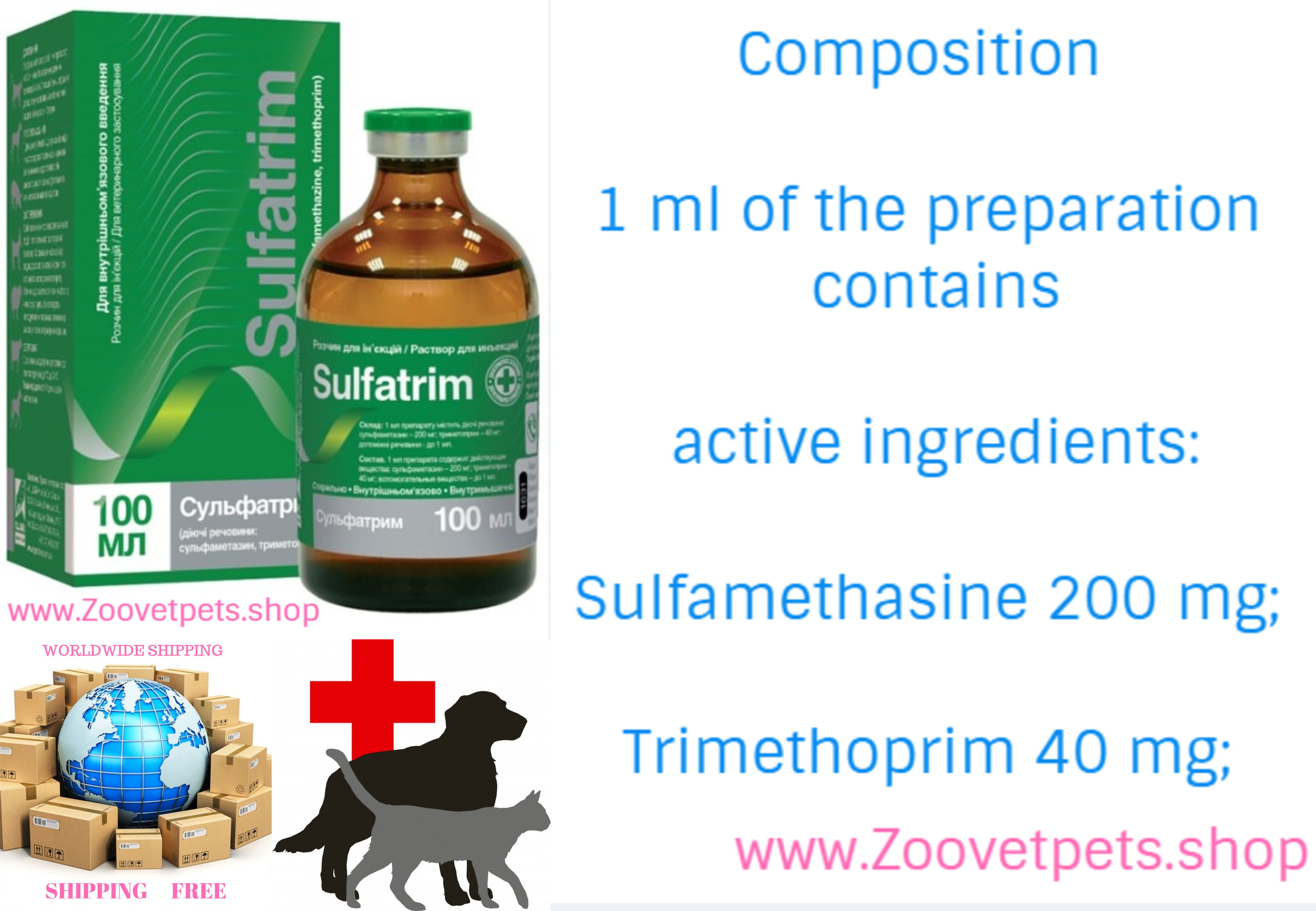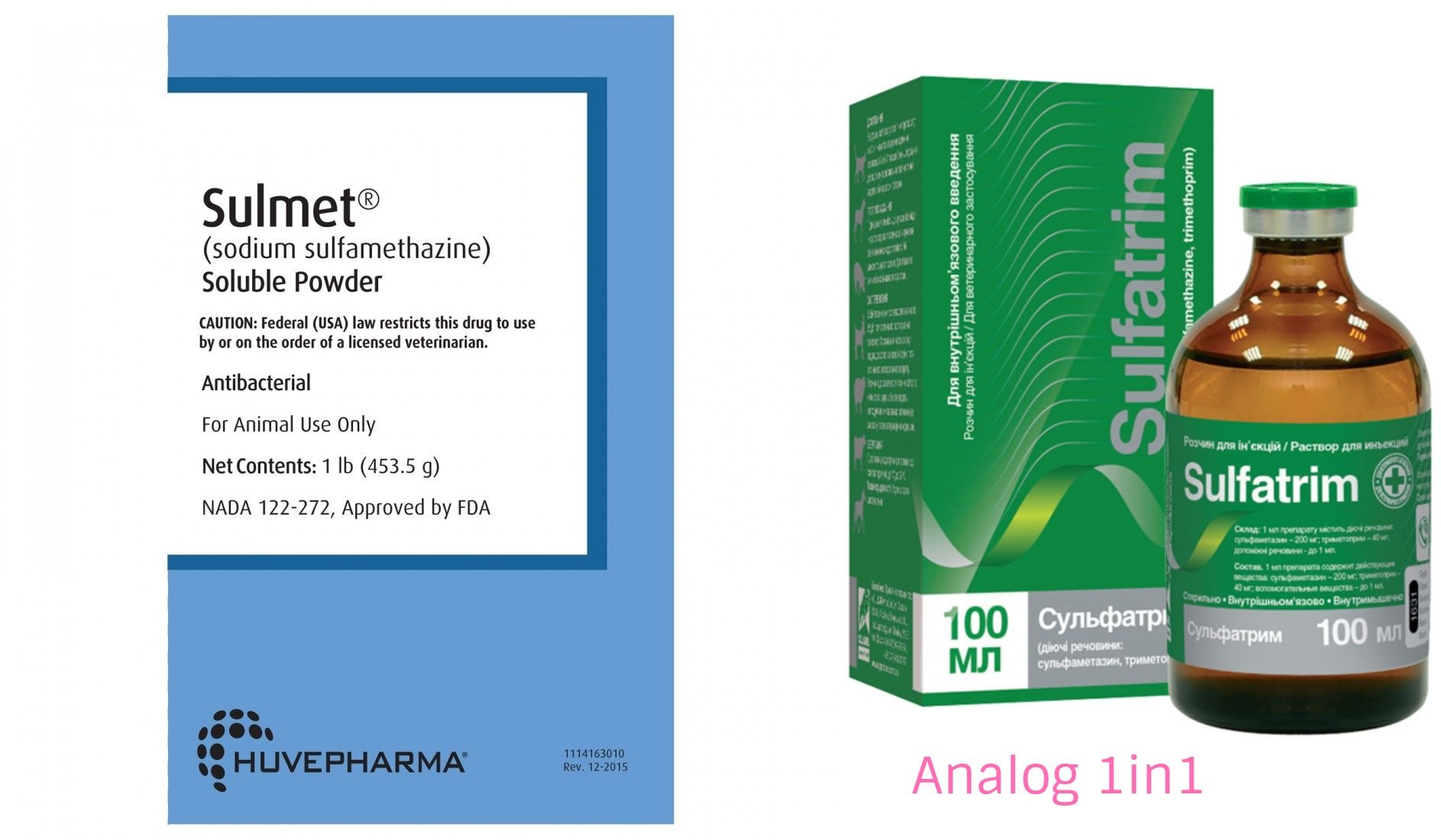Description
Solution of yellowish color.
Composition :
1 ml of the preparation contains
active ingredients:
Sulfametazine 200 mg;
Trimethoprim 40 mg;
Pharmacological properties:
Sulfametazine is a synthetic chemotherapeutic agent from the sulfamide group. Trimethoprim is a synthetic chemotherapeutic agent derived from diaminopyrimidine.
Separately, each component has a bacteriostatic effect, but sulfametazine and trimethoprim, taken in a ratio of 4:1, strengthen the action of each other and give the drug a bactericidal character of action.
This synergy is due to the fact that the components influence two sequential processes, which are necessary for the synthesis of tetrahydrofolic acid or bacterial folic acid, which plays a major role in the synthesis of bacterial purines. The bacterial wall is impermeable to folates, so purine synthesis depends on the microorganisms’ own synthesizing capacity.
The effect of these two components is as follows:
– Sulfametazine is chemically similar to p-aminobenzoic acid and is involved in the formation of dihydropteroylsinthetase enzymes to counteract the formation of dihydrofolic acid;
– trimethoprim blocks the next link in the biosynthetic chain, inhibiting the action of dihydrofolate reductase – an enzyme that accelerates the conversion of dihydrofolic acid into tetrahydrofolic acid.
The combination of these chemotherapeutic components provides the drug with bactericidal activity. At the same time, the appearance of strains of microorganisms resistant to the drug is insignificant.
The combination of sulfametazine-trimethoprim has a wide range of effects, including gram-positive and gram-negative bacteria. Microorganisms that are very sensitive to the drug include the following bacteria: Escherichia coli, Clostridium spp., Shigella spp., Salmonella spp, Proteus mirabilis, Bacillus anthracis, Pasteurella spp., Haemophilus influenzae, Haemophilus gallinarum, Vibrio spp., Streptococcus pneumoniae, Streptococcus pyogenes, Streptococcus faecalis, Streptococcus virulam, Streptococcus agalactiae, Staphylococcus aureus, Proteus spp. and Brucella spp.
Application:
Cattle: Treatment of animals with colibacillosis and salmonellosis gastroenteritis, vibriosis, pneumonia, septicaemia, pasteurellosis, streptococcosis, staphylococcosis and colibacillosis mastitis, actinomycosis, purulent abscesses, as well as diseases of the genitourinary system caused by microorganisms sensitive to sulfametazim and trimethoprim.
Horses: treatment of animals with diarrhea, pneumonia, piosepticaemia caused by microorganisms sensitive to sulfamethasim and trimethoprim.
Pigs: treatment of animals with colibacillosis, salmonellosis, vibriosis dysentery, pneumonia, pasteurellosis, malignant edema, abscesses caused by microorganisms sensitive to sulfametazim and trimethoprim.
Sheep, goats: treatment of animals suffering from colibacillosis, salmonellosis, vibriosis dysentery, pneumonia, enteritis, abscess, mastitis caused by microorganisms sensitive to sulfametazim and trimethoprim.
Dogs, cats: treatment of animals with pulmonary infections, septicemia, bacterial enteritis, coccidiosis in dogs caused by microorganisms sensitive to sulfametazim and trimethoprim.
Dosage:
Intramuscularly in a dose of 1 ml per 22 lb (10 kg) of animal body weight daily for 3-5 days. On the first day of treatment, the daily dose is divided into two parts and administered at intervals of 12 hours.
Contraindications:
Hypersensitivity to sulfonamides. Do not use animals with kidney or liver failure. Do not use together with folates and p-aminobenzoic drugs
Cautions:
Killing animals for meat is allowed 28 days after the last application of the drug. Milk consumption for food is allowed after 4 days after the last use of the preparation. Meat and milk obtained before this date are disposed of or fed to unproductive animals, depending on the opinion of the veterinarian.
Storage:
Dry, dark, inaccessible for children at temperatures between 40-777F (5 ° to 25 ° C).
Shelf life – 5 years from the date of manufacture.










Reviews
There are no reviews yet.